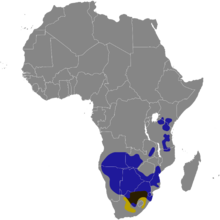
Back Wildebees Afrikaans نو (حيوان) Arabic نو (جنس من الثدييات) ARZ Connochaetes AST Гну AV Eyundol (Connochaetes) AVK Qnu Azerbaijani Гну Bashkir Гнута Bulgarian Gnou Breton
| Wildebeest Temporal range: Early Pleistocene – present
| |
|---|---|

| |
| Blue wildebeest, C. taurinus Ngorongoro Crater, Tanzania | |

| |
| Black wildebeest, C. gnou Krugersdorp Game Reserve, South Africa | |
| Scientific classification | |
| Domain: | Eukaryota |
| Kingdom: | Animalia |
| Phylum: | Chordata |
| Class: | Mammalia |
| Order: | Artiodactyla |
| Family: | Bovidae |
| Subfamily: | Alcelaphinae |
| Genus: | Connochaetes Hinrich Lichtenstein, 1812 |
| Type species | |
| Antilope gnu[1] | |
| Species | |
|
Connochaetes gnou – black wildebeest | |

| |
| Range map: Black wildebeest shown yellow Blue wildebeest shown blue Overlapping range shown brown | |
Wildebeest (/ˈwɪldɪbiːst/ WIL-dib-eest,[2][3][4] /ˈvɪl-/ VIL-,[4]), also called gnu (/nuː/ NOO or /njuː/ NEW),[5][6][7] are antelopes of the genus Connochaetes and native to Eastern and Southern Africa. They belong to the family Bovidae, which includes true antelopes, cattle, goats, sheep, and other even-toed horned ungulates. There are two species of wildebeest: the black wildebeest or white-tailed gnu (C. gnou), and the blue wildebeest or brindled gnu (C. taurinus).
Fossil records suggest these two species diverged about one million years ago, resulting in a northern and a southern species. The blue wildebeest remained in its original range and changed very little from the ancestral species, while the black wildebeest changed more as adaptation to its open grassland habitat in the south. The most obvious ways of telling the two species apart are the differences in their colouring and in the way their horns are oriented.[8]
In East Africa, the blue wildebeest is the most abundant big-game species; some populations perform an annual migration to new grazing grounds, but the black wildebeest is merely nomadic. Breeding in both takes place over a short period of time at the end of the rainy season and the calves are soon active and are able to move with the herd, a fact necessary for their survival. Nevertheless, some fall prey to large carnivores, especially the spotted hyena.
Wildebeest often graze in mixed herds with zebra, which gives heightened awareness of potential predators. They are also alert to the warning signals emitted by other animals such as baboons. Wildebeest are a tourist attraction but compete with domesticated livestock for pasture and are sometimes blamed by farmers for transferring diseases and parasites to their cattle.[citation needed] Illegal hunting does take place but the population trend is fairly stable. Wildebeest can also be found in national parks or on private land. The International Union for Conservation of Nature lists both kinds of wildebeest as least-concern species.
- ^ Wilson, D. E.; Reeder, D. M., eds. (2005). Mammal Species of the World: A Taxonomic and Geographic Reference (3rd ed.). Johns Hopkins University Press. ISBN 978-0-8018-8221-0. OCLC 62265494.
- ^ "Wildebeest | Define Wildebeest at Dictionary.com". Dictionary.reference.com. Retrieved 25 March 2014.
- ^ "wildebeest noun – definition in the British English Dictionary & Thesaurus – Cambridge Dictionaries Online". Dictionary.cambridge.org. 18 February 2014. Retrieved 25 March 2014.
- ^ a b "wildebeest – definition of wildebeest by the Free Online Dictionary, Thesaurus and Encyclopedia". Thefreedictionary.com. Retrieved 25 March 2014.
- ^ "Gnu | Define Gnu at Dictionary.com". Dictionary.reference.com. 12 April 1997. Retrieved 25 March 2014.
- ^ "gnu noun – definition in the British English Dictionary & Thesaurus – Cambridge Dictionaries Online". Dictionary.cambridge.org. 18 February 2014. Retrieved 25 March 2014.
- ^ "gnu – definition of gnu by the Free Online Dictionary, Thesaurus and Encyclopedia". Thefreedictionary.com. Retrieved 25 March 2014.
- ^ "Wildebeests in Africa! Visit Africa". visitafrica.site. Retrieved 16 July 2020.